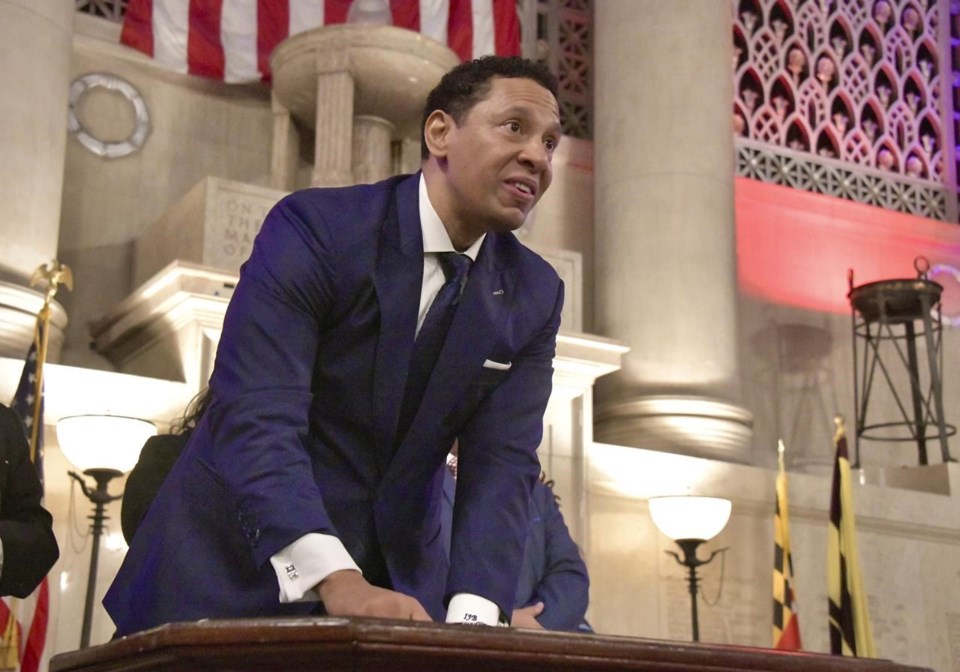BALTIMORE (AP) — In one of his first high-profile decisions after taking office earlier this month, Baltimore’s new top prosecutor declined to bring criminal charges against a local police officer who fatally shot a fleeing teenage driver last year.
The decision came despite an that found the driver “no longer posed a threat” when Baltimore police officer Connor Murray fired the fatal shot. Murray and other officers were pursuing Donnell Rochester, 18, for outstanding bench warrants resulting from his failure to appear on a pending carjacking charge.
Baltimore State’s Attorney Ivan Bates released his decision last week. The former defense attorney was elected last year after defeating then-incumbent Marilyn Mosby in a Democratic primary. Mosby gained national recognition after bringing criminal charges against the officers involved in Freddie Gray’s 2015 death.
After reviewing evidence from the February 2022 police shooting, Bates found two officers acted “reasonably and lawfully” when they opened fire on Rochester’s moving vehicle, according to a . Rochester was driving toward Murray, creating a “life threatening situation,” the report said.
But another review of the case — conducted by the Maryland Attorney General’s Independent Investigations Division — found prosecutors could likely prove Murray committed voluntary manslaughter. That review was released Tuesday.
The , which investigates fatal encounters with law enforcement, was created in 2021 amid a push among Maryland legislators to across the state. Though its investigators release their findings to local prosecutors and the public, the written reports stop short of recommending criminal charges or lack thereof; charging decisions ultimately fall to local prosecutors.
Of the 27 cases reviewed by the division since fall 2021, none have resulted in charges against the officers involved, according to agency data. Nearly half the cases are still under investigation or awaiting a charging decision.
The argument for voluntary manslaughter in the Rochester case focuses on the fourth shot Murray fired, which lodged in Rochester’s chest, killing him. That shot — the only one that struck Rochester — could likely be considered unreasonable because Murray pulled the trigger moments after jumping away from the moving vehicle, falling down and removing himself from its path.
However, investigators also said the standard for legal review specifically notes police officers “are often forced to make split-second judgments — in circumstances that are tense, uncertain, and rapidly evolving — about the amount of force that is necessary in a particular situation.”
With less than a second in between the third and fourth shots, investigators said, it’s possible Murray didn’t have time to realize the threat had passed and act accordingly.
Rochester had evaded a traffic stop minutes earlier, then parked on a residential street and exited his car. He got back behind the wheel and started driving off when he saw police approaching on foot. The violent encounter unfolded within seconds.
After the shooting, Rochester’s car came to a sudden stop, and he stepped out with his hands up before falling to his knees, bodycam footage shows. He was pronounced dead after medics arrived and brought him to a hospital.
In the weeks that followed, protesters gathered outside City Hall and Baltimore Police Headquarters, demanding criminal charges against the officers involved. Rochester’s loved ones described his infectious smile and dreams of becoming a Hollywood star. They questioned why Rochester was killed over a missed court date.
Moments after firing his service weapon, Murray said he thought Rochester’s car hit his leg, but then he changed his account, saying it must have missed him, according to the investigative report. Murray, who joined the Baltimore police force after completing training academy in 2019, wasn’t involved in any prior shootings.
Investigators said Murray may have experienced pain from falling and assumed the car struck him. “On the other hand,” they said, he could have been trying to “exaggerate the threat he faced, thereby attempting to make his use of force appear more reasonable.”
After Murray’s four shots, another officer, Robert Mauri, fired twice from down the street. Neither of his bullets struck Rochester.
Mauri later said he believed his colleague was about to be run over, a statement investigators found credible. But they said prosecutors could consider an attempted voluntary manslaughter charge against Mauri because he should have realized the other officer was no longer in danger before pulling the trigger.
In addition to analyzing potential criminal charges, investigators considered whether the officers violated the Baltimore Police Department’s internal policies during the encounter.
Less than a year before the shooting, both Murray and Mauri completed training that specifically warned against firing at moving vehicles, according to the report. Department policy also tells officers to avoid placing themselves in the path of a moving vehicle whenever possible.
Officers are trained to continually assess whether deadly force is needed, including in between gunshots, the report says. Deadly force is warranted only in the face of an immediate threat of death or severe injury, according to department policy.
A de-escalation policy also instructs officers to approach suspects slowly and deliberately to avoid physical confrontations. Murray likely violated that policy by “running directly at the front of Mr. Rochester’s Honda,” investigators found.
Both officers involved in the shooting remain on administrative duty pending the results of an internal investigation to determine whether they will face discipline, a department spokesperson said Wednesday. Officials declined to comment on either the investigative report or Bates’ decision not to bring charges.
Bates’ office also didn’t respond to a request for comment Wednesday.
Lea Skene, The Associated Press


